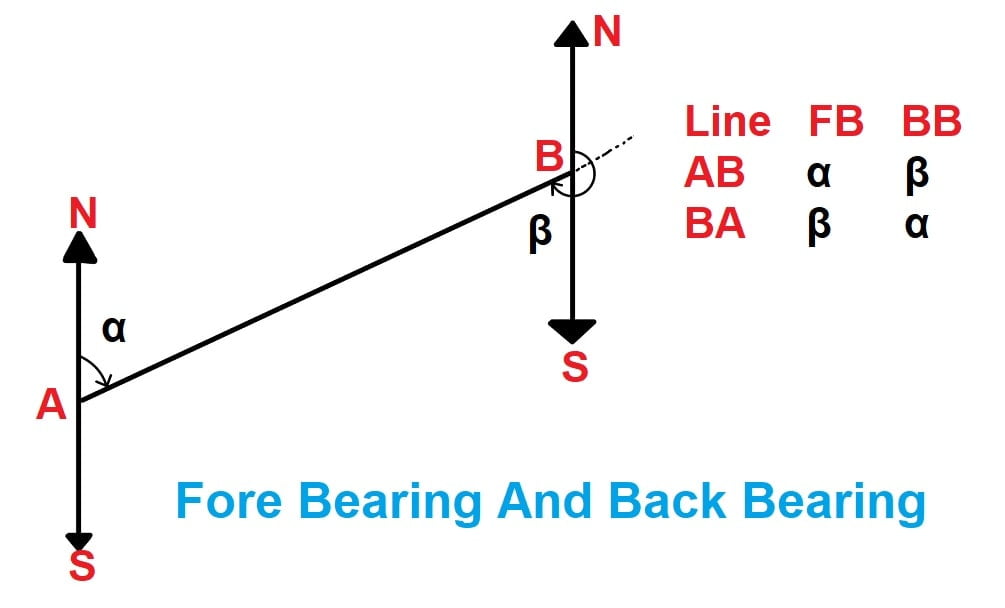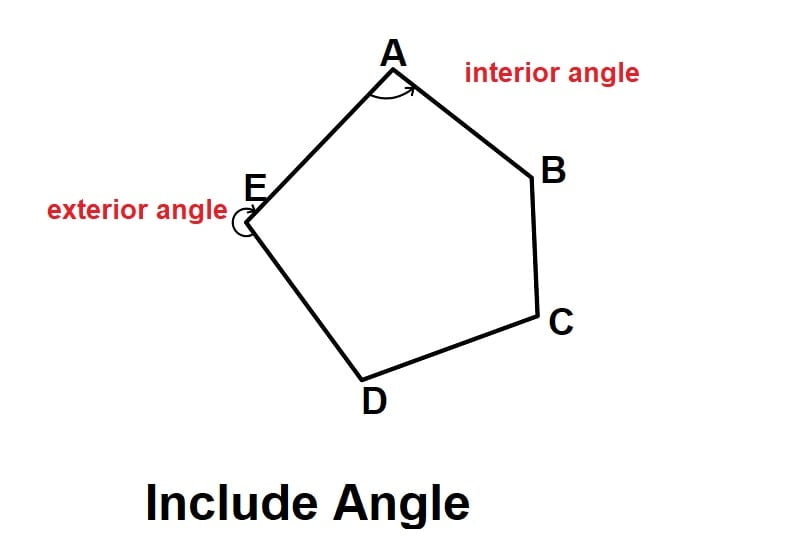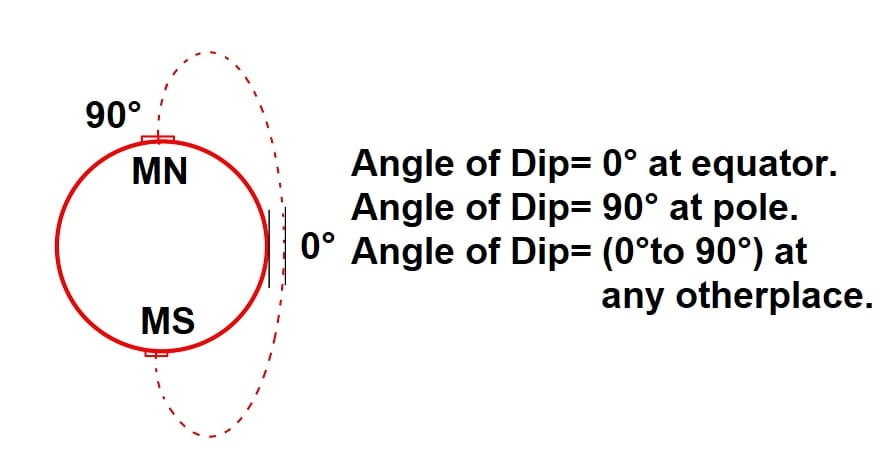Fore Bearing And Back Bearing
- Bearing measured from one station to adjacent next station in the direction of traverse is called fore bearing.
- Bearing measured from one station to adjacent previous stations in the opposite direction to traverse is called back bearing.
- That fore bearing and back bearing of a line have a difference of 180°.

Relationship Between Fore Bearing And Back Bearing
The Back Bearing of a line can be determined if its Fore Bearing is given and vice versa,
Case.1 If the Fore Bearing of a line is given as the whole circle bearing,
- Back Bearing = Fore bearing + 180″, if F.B. <180° and,
- Back Bearing = Force bearing – 180, if F.B. > 180°.
- B.B. = F.B ± 180°
Case.2 If the Fore Bearing of a line is given as the Quadrantal Bearing,
- Back Bearing = Numerically equal to Fore Bearing
- Just change N for S, and vice versa and E for W. and vice versa.
- Example: N30°E → S30°W
There is no need to memories any rules when converting the Whole Circle Bearing to the Quadrantal Bearing or vice versa, or when determining the Back Bearing from the Fore Bearing. It is recommended that you always construct a preliminary sketch and calculate the needed Bearing directly.
Include Angle
- The included angle is the angle formed when two lines intersect at a point. The included angle can be either interior angle or exterior angle.
- If the bearing of lines is known, included angles can be calculated.
- However, in surveying, an included angle is defined as “an angle measured clockwise from the previous line of a transverse to the forward line.”

Case.1 When the traverse runs in clockwise direction the included angle will be exterior angle.
Case.2 When the traverse runs in the anticlockwise direction the included angle will be the interior angle.

Magnetic Declination
- Horizontal angle between the true meridian and magnetic meridian is called magnetic declination.
- Magnetic declination is not constant even for a particular place. Its value continuously changes. Change in declination is called variation.
Type of Declination
There are two types of declination.
- Eastern Declination
- Western Declination

Eastern Declination
The declination is considered to be eastern declination or positive declination if the magnetic north(MN) is on the east side of the true north (N).
True Bearing (TB) = Magnetic Bearing (MB) + Declination(δE)
Western Declination
The declination is considered to be western declination or negative declination when the magnetic north (MN) is on the west side of true north (N).
True Bearing (TB) = Magnetic Bearing (MB) – Declination(δW)
Variation of Magnetic Declination
The declination at a place does not remain constant, but it varies from time to time. Basically there can be four types of magnetic declination at a place based on the pattern of these variations.
- Secular Variation
- Annual Variation
- Diurnal Variation
- Irregular Variation
Secular Variation
Secular variation of declination occurs continuously over a long period of time. Still there is no reliable method of predicting the secular variation at a place. The annual rate of change of secular variation is generally between 5 to 10 minutes.
Diurnal Variation
Diurnal Variation is the change in the declination at a place in 24 hr. It is because of the rotation of earth about its own axis. The amount of variation is from a fraction of a minute to over 12′.
Annual Variation
Annual Variation is the change in the declination at a place over a period of 1 year. It is caused because of the rotation of earth about the sun. The annual rate of change of annual variation is generally between 1-2 min.
Irregular Variation
Magnetic disturbances in the earth’s magnetic field cause the irregular variation.Such variations are uncertain, unpredictable and random in nature. It is due to natural phenomena such as earthquakes, volcanic eruptions also cause irregular variation of declination. The irregular variation may be quite large, depending upon the magnitude of the disturbances. The irregular variation upto 2° have been observed at few places on the earth.
Adjustments Of Angles
In a closed traverse, the theoretical sum of the internal included angles should be equal to (2N-4) right angles, where N is the number of sides of the traverse. & the theoretical sum of the external included angles should be equal to (2N+4) right angles.
Angle of Dip
Vertical angle made by a magnetic flux line with earth surface is called angle of dip. In the northern hemisphere northern ends dip downward and south hemisphere southern dip downward.
- Angle of Dip= 0° at equator.
- Angle of Dip= 90° at pole.
- Angle of Dip= (0°to 90°) at any otherplace.

Local Attraction
Local attraction is an error include a needle of magnetic compass due to presence of local magnetic object like: current passing electric wire, steel bridge, some other object etc
Due to the presence of local magnetic objects, the magnetic needle is deflected from actual magnetic flux direction.
Observation
1). If for any line |FB-BB| ≠ 180 then stations are affected by local attraction.
2). If for any line |FB-BB| =180 then there are two possibilities.
- Both stations are free from local attraction.
- Both stations are affected by the same value of local attraction.
Note. For calculation point of view only the first condition is consider.
3). If any station is affected by local attraction then all the bearing measured from that each station will have the same value of local attraction hence same correction also.
Internal/external angles at any station will not be affected by local attraction even if stations are affected.
FOR MORE INFORMATION ABOUT SURVEYING